The Kyoto Protocol Agreement: Objectives, Mechanisms, and Comparison with Paris Climate Agreement
VerifiedAdded on 2023/06/15
|10
|1801
|275
AI Summary
This article discusses the Kyoto Protocol Agreement, its objectives, and mechanisms such as universal emissions trading, clean improvement mechanism, and joint implementation. It also compares the Kyoto Protocol Agreement with the Paris Climate Agreement and highlights Australia's agreed emission levels. Additionally, the article explores the impact of electric vehicles on the electric grid.
Contribute Materials
Your contribution can guide someone’s learning journey. Share your
documents today.
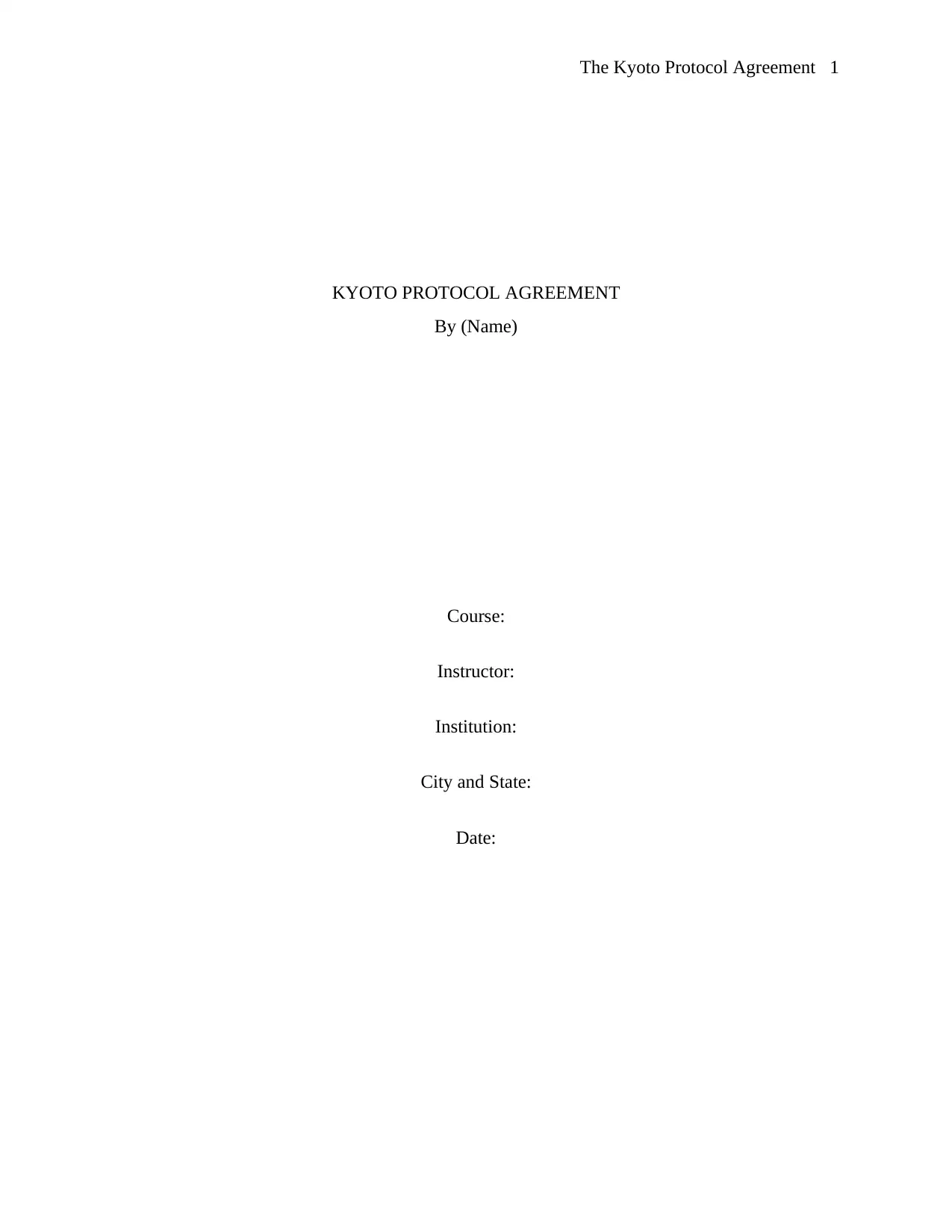
The Kyoto Protocol Agreement 1
KYOTO PROTOCOL AGREEMENT
By (Name)
Course:
Instructor:
Institution:
City and State:
Date:
KYOTO PROTOCOL AGREEMENT
By (Name)
Course:
Instructor:
Institution:
City and State:
Date:
Secure Best Marks with AI Grader
Need help grading? Try our AI Grader for instant feedback on your assignments.
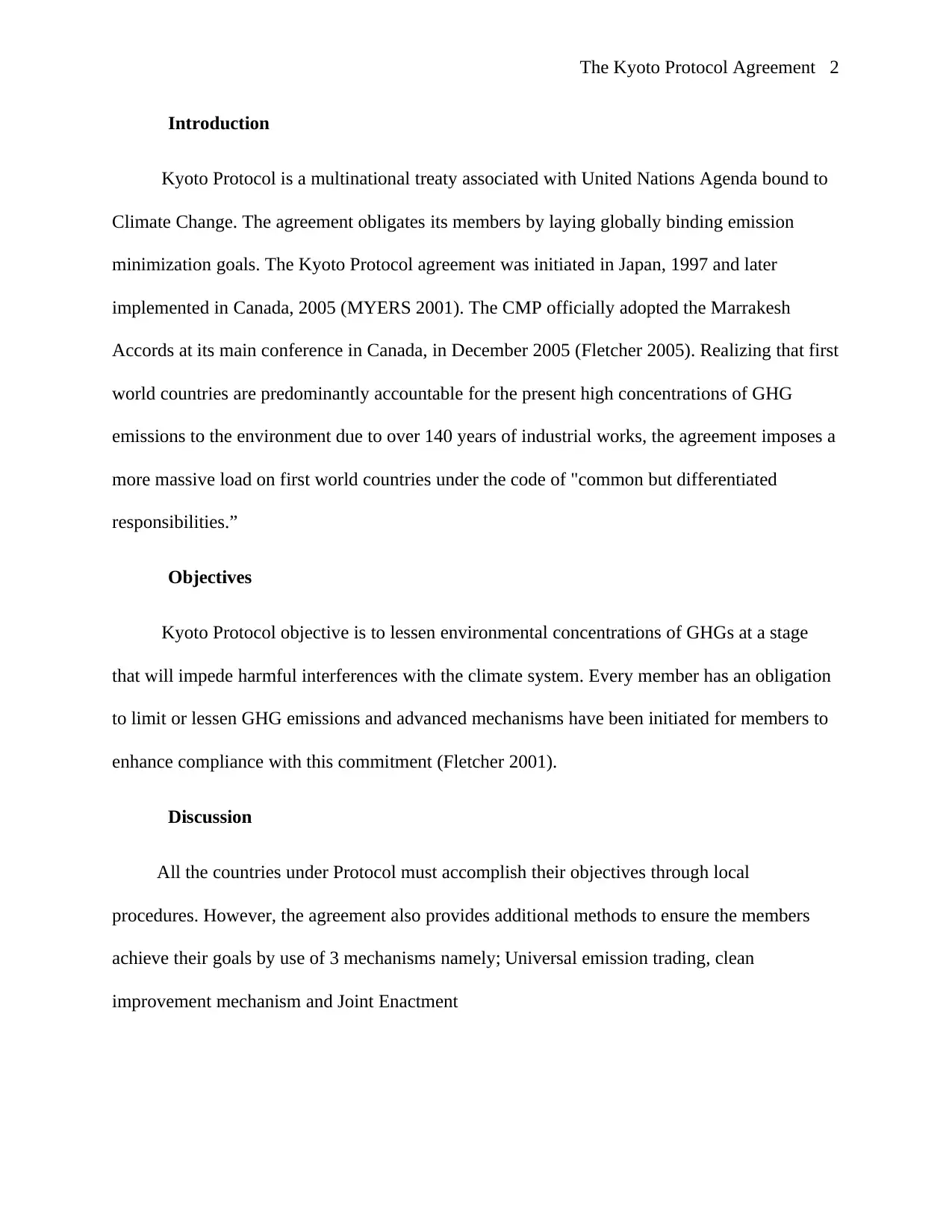
The Kyoto Protocol Agreement 2
Introduction
Kyoto Protocol is a multinational treaty associated with United Nations Agenda bound to
Climate Change. The agreement obligates its members by laying globally binding emission
minimization goals. The Kyoto Protocol agreement was initiated in Japan, 1997 and later
implemented in Canada, 2005 (MYERS 2001). The CMP officially adopted the Marrakesh
Accords at its main conference in Canada, in December 2005 (Fletcher 2005). Realizing that first
world countries are predominantly accountable for the present high concentrations of GHG
emissions to the environment due to over 140 years of industrial works, the agreement imposes a
more massive load on first world countries under the code of "common but differentiated
responsibilities.”
Objectives
Kyoto Protocol objective is to lessen environmental concentrations of GHGs at a stage
that will impede harmful interferences with the climate system. Every member has an obligation
to limit or lessen GHG emissions and advanced mechanisms have been initiated for members to
enhance compliance with this commitment (Fletcher 2001).
Discussion
All the countries under Protocol must accomplish their objectives through local
procedures. However, the agreement also provides additional methods to ensure the members
achieve their goals by use of 3 mechanisms namely; Universal emission trading, clean
improvement mechanism and Joint Enactment
Introduction
Kyoto Protocol is a multinational treaty associated with United Nations Agenda bound to
Climate Change. The agreement obligates its members by laying globally binding emission
minimization goals. The Kyoto Protocol agreement was initiated in Japan, 1997 and later
implemented in Canada, 2005 (MYERS 2001). The CMP officially adopted the Marrakesh
Accords at its main conference in Canada, in December 2005 (Fletcher 2005). Realizing that first
world countries are predominantly accountable for the present high concentrations of GHG
emissions to the environment due to over 140 years of industrial works, the agreement imposes a
more massive load on first world countries under the code of "common but differentiated
responsibilities.”
Objectives
Kyoto Protocol objective is to lessen environmental concentrations of GHGs at a stage
that will impede harmful interferences with the climate system. Every member has an obligation
to limit or lessen GHG emissions and advanced mechanisms have been initiated for members to
enhance compliance with this commitment (Fletcher 2001).
Discussion
All the countries under Protocol must accomplish their objectives through local
procedures. However, the agreement also provides additional methods to ensure the members
achieve their goals by use of 3 mechanisms namely; Universal emission trading, clean
improvement mechanism and Joint Enactment
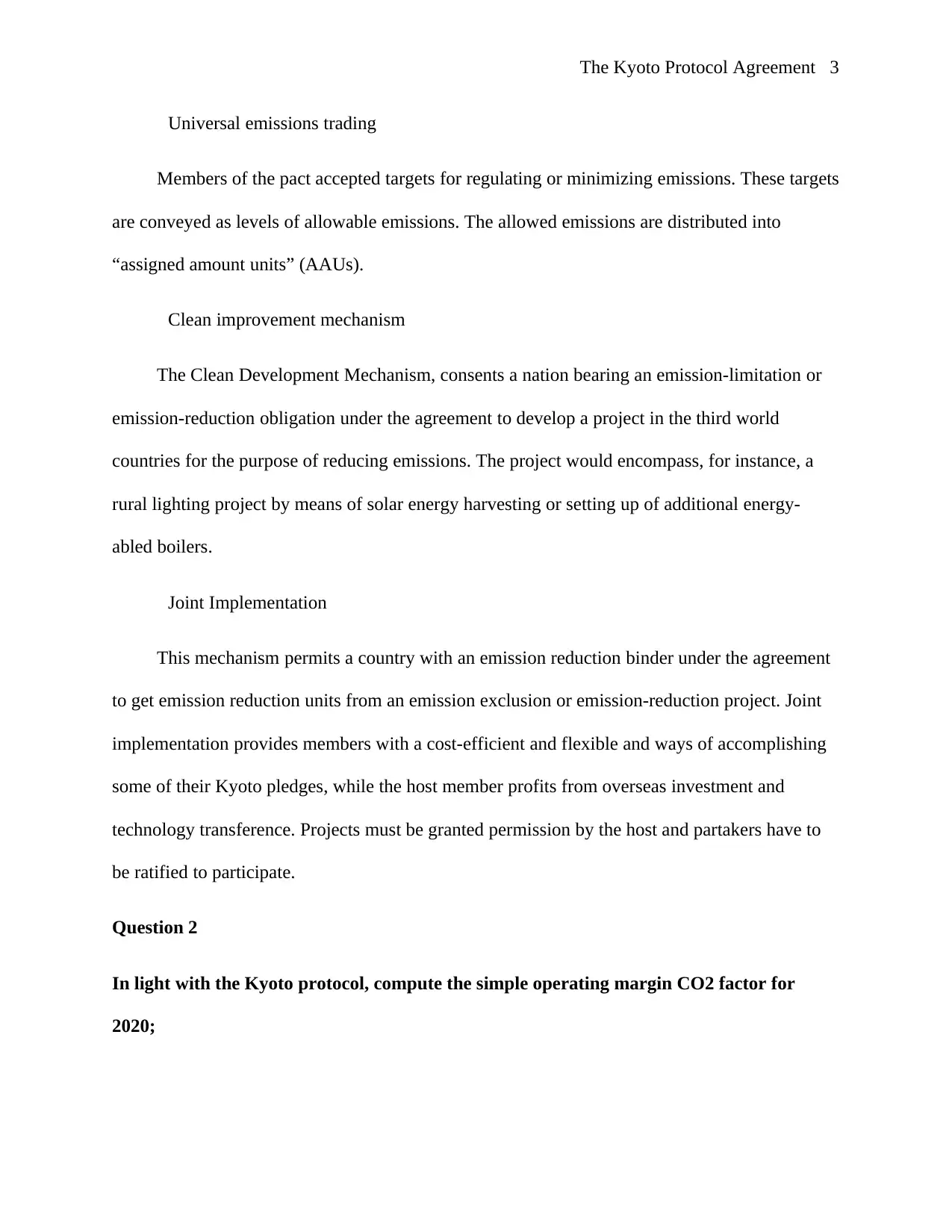
The Kyoto Protocol Agreement 3
Universal emissions trading
Members of the pact accepted targets for regulating or minimizing emissions. These targets
are conveyed as levels of allowable emissions. The allowed emissions are distributed into
“assigned amount units” (AAUs).
Clean improvement mechanism
The Clean Development Mechanism, consents a nation bearing an emission-limitation or
emission-reduction obligation under the agreement to develop a project in the third world
countries for the purpose of reducing emissions. The project would encompass, for instance, a
rural lighting project by means of solar energy harvesting or setting up of additional energy-
abled boilers.
Joint Implementation
This mechanism permits a country with an emission reduction binder under the agreement
to get emission reduction units from an emission exclusion or emission-reduction project. Joint
implementation provides members with a cost-efficient and flexible and ways of accomplishing
some of their Kyoto pledges, while the host member profits from overseas investment and
technology transference. Projects must be granted permission by the host and partakers have to
be ratified to participate.
Question 2
In light with the Kyoto protocol, compute the simple operating margin CO2 factor for
2020;
Universal emissions trading
Members of the pact accepted targets for regulating or minimizing emissions. These targets
are conveyed as levels of allowable emissions. The allowed emissions are distributed into
“assigned amount units” (AAUs).
Clean improvement mechanism
The Clean Development Mechanism, consents a nation bearing an emission-limitation or
emission-reduction obligation under the agreement to develop a project in the third world
countries for the purpose of reducing emissions. The project would encompass, for instance, a
rural lighting project by means of solar energy harvesting or setting up of additional energy-
abled boilers.
Joint Implementation
This mechanism permits a country with an emission reduction binder under the agreement
to get emission reduction units from an emission exclusion or emission-reduction project. Joint
implementation provides members with a cost-efficient and flexible and ways of accomplishing
some of their Kyoto pledges, while the host member profits from overseas investment and
technology transference. Projects must be granted permission by the host and partakers have to
be ratified to participate.
Question 2
In light with the Kyoto protocol, compute the simple operating margin CO2 factor for
2020;
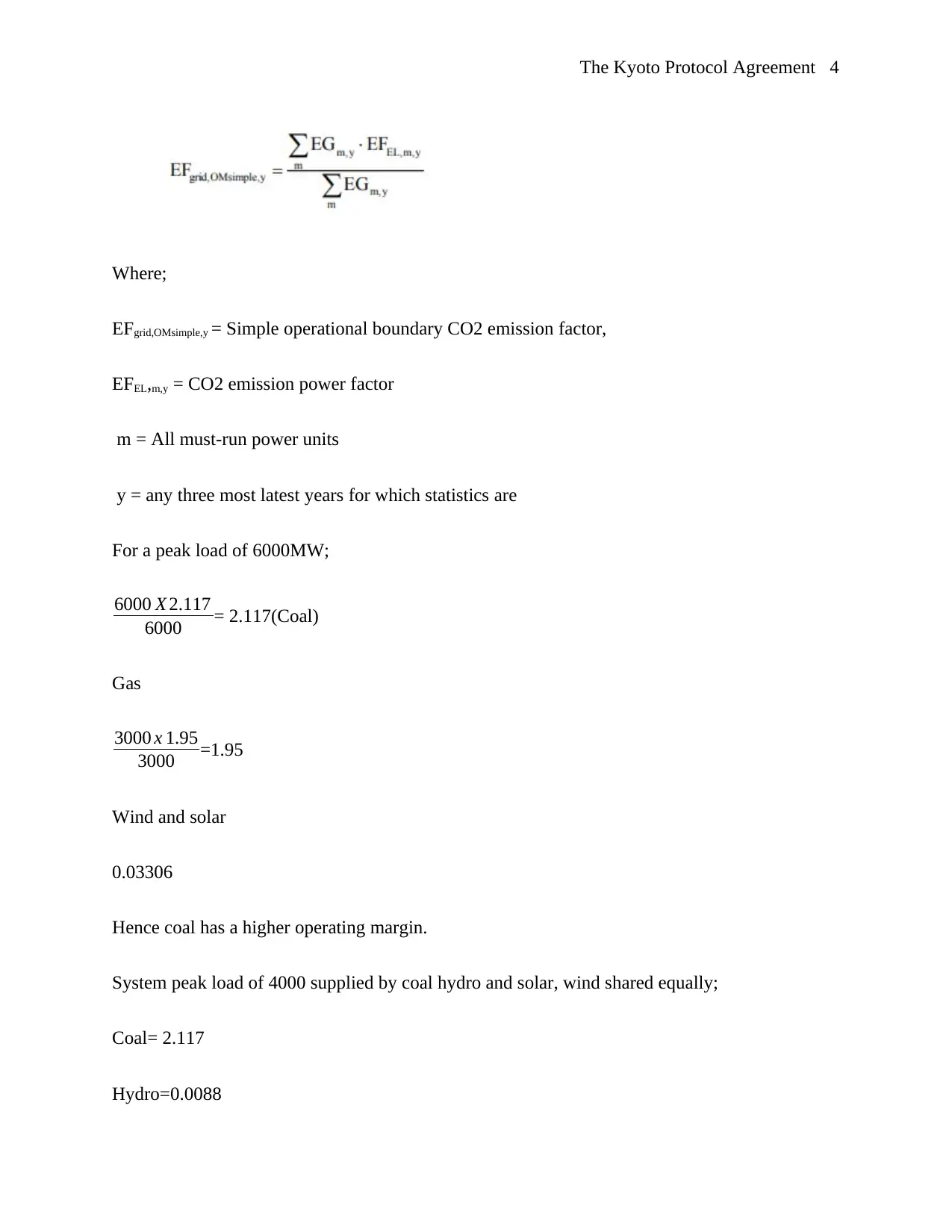
The Kyoto Protocol Agreement 4
Where;
EFgrid,OMsimple,y = Simple operational boundary CO2 emission factor,
EFEL,m,y = CO2 emission power factor
m = All must-run power units
y = any three most latest years for which statistics are
For a peak load of 6000MW;
6000 X 2.117
6000 = 2.117(Coal)
Gas
3000 x 1.95
3000 =1.95
Wind and solar
0.03306
Hence coal has a higher operating margin.
System peak load of 4000 supplied by coal hydro and solar, wind shared equally;
Coal= 2.117
Hydro=0.0088
Where;
EFgrid,OMsimple,y = Simple operational boundary CO2 emission factor,
EFEL,m,y = CO2 emission power factor
m = All must-run power units
y = any three most latest years for which statistics are
For a peak load of 6000MW;
6000 X 2.117
6000 = 2.117(Coal)
Gas
3000 x 1.95
3000 =1.95
Wind and solar
0.03306
Hence coal has a higher operating margin.
System peak load of 4000 supplied by coal hydro and solar, wind shared equally;
Coal= 2.117
Hydro=0.0088
Secure Best Marks with AI Grader
Need help grading? Try our AI Grader for instant feedback on your assignments.
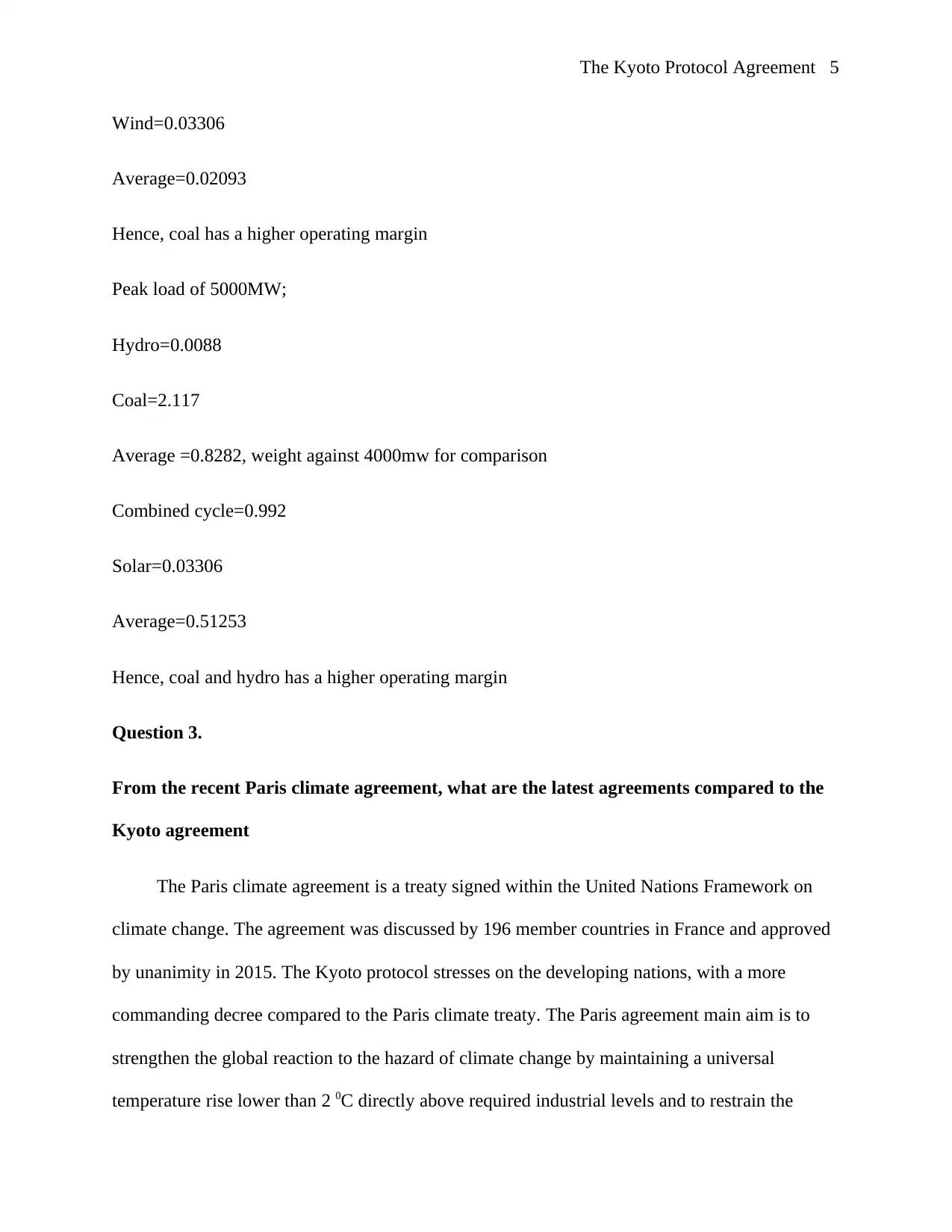
The Kyoto Protocol Agreement 5
Wind=0.03306
Average=0.02093
Hence, coal has a higher operating margin
Peak load of 5000MW;
Hydro=0.0088
Coal=2.117
Average =0.8282, weight against 4000mw for comparison
Combined cycle=0.992
Solar=0.03306
Average=0.51253
Hence, coal and hydro has a higher operating margin
Question 3.
From the recent Paris climate agreement, what are the latest agreements compared to the
Kyoto agreement
The Paris climate agreement is a treaty signed within the United Nations Framework on
climate change. The agreement was discussed by 196 member countries in France and approved
by unanimity in 2015. The Kyoto protocol stresses on the developing nations, with a more
commanding decree compared to the Paris climate treaty. The Paris agreement main aim is to
strengthen the global reaction to the hazard of climate change by maintaining a universal
temperature rise lower than 2 0C directly above required industrial levels and to restrain the
Wind=0.03306
Average=0.02093
Hence, coal has a higher operating margin
Peak load of 5000MW;
Hydro=0.0088
Coal=2.117
Average =0.8282, weight against 4000mw for comparison
Combined cycle=0.992
Solar=0.03306
Average=0.51253
Hence, coal and hydro has a higher operating margin
Question 3.
From the recent Paris climate agreement, what are the latest agreements compared to the
Kyoto agreement
The Paris climate agreement is a treaty signed within the United Nations Framework on
climate change. The agreement was discussed by 196 member countries in France and approved
by unanimity in 2015. The Kyoto protocol stresses on the developing nations, with a more
commanding decree compared to the Paris climate treaty. The Paris agreement main aim is to
strengthen the global reaction to the hazard of climate change by maintaining a universal
temperature rise lower than 2 0C directly above required industrial levels and to restrain the
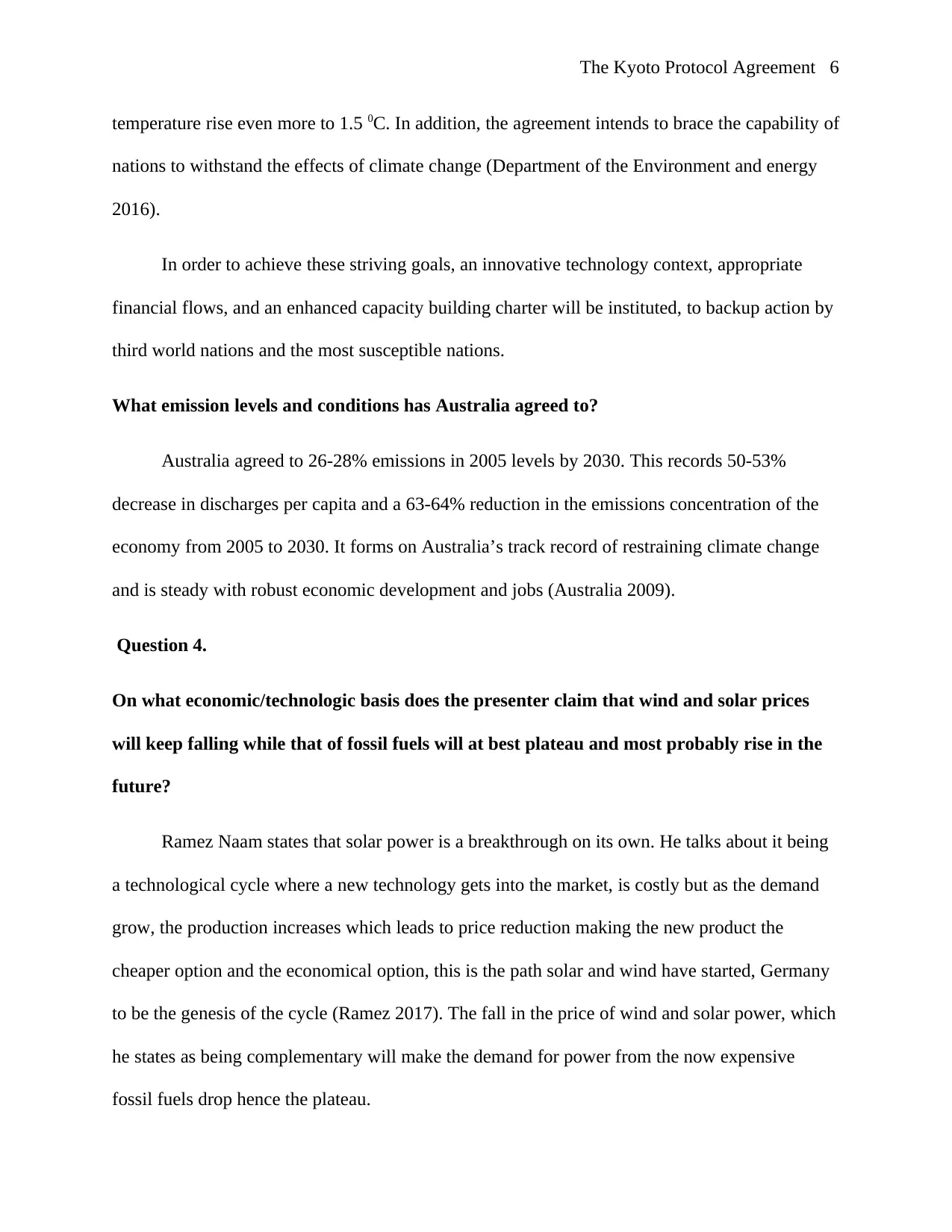
The Kyoto Protocol Agreement 6
temperature rise even more to 1.5 0C. In addition, the agreement intends to brace the capability of
nations to withstand the effects of climate change (Department of the Environment and energy
2016).
In order to achieve these striving goals, an innovative technology context, appropriate
financial flows, and an enhanced capacity building charter will be instituted, to backup action by
third world nations and the most susceptible nations.
What emission levels and conditions has Australia agreed to?
Australia agreed to 26-28% emissions in 2005 levels by 2030. This records 50-53%
decrease in discharges per capita and a 63-64% reduction in the emissions concentration of the
economy from 2005 to 2030. It forms on Australia’s track record of restraining climate change
and is steady with robust economic development and jobs (Australia 2009).
Question 4.
On what economic/technologic basis does the presenter claim that wind and solar prices
will keep falling while that of fossil fuels will at best plateau and most probably rise in the
future?
Ramez Naam states that solar power is a breakthrough on its own. He talks about it being
a technological cycle where a new technology gets into the market, is costly but as the demand
grow, the production increases which leads to price reduction making the new product the
cheaper option and the economical option, this is the path solar and wind have started, Germany
to be the genesis of the cycle (Ramez 2017). The fall in the price of wind and solar power, which
he states as being complementary will make the demand for power from the now expensive
fossil fuels drop hence the plateau.
temperature rise even more to 1.5 0C. In addition, the agreement intends to brace the capability of
nations to withstand the effects of climate change (Department of the Environment and energy
2016).
In order to achieve these striving goals, an innovative technology context, appropriate
financial flows, and an enhanced capacity building charter will be instituted, to backup action by
third world nations and the most susceptible nations.
What emission levels and conditions has Australia agreed to?
Australia agreed to 26-28% emissions in 2005 levels by 2030. This records 50-53%
decrease in discharges per capita and a 63-64% reduction in the emissions concentration of the
economy from 2005 to 2030. It forms on Australia’s track record of restraining climate change
and is steady with robust economic development and jobs (Australia 2009).
Question 4.
On what economic/technologic basis does the presenter claim that wind and solar prices
will keep falling while that of fossil fuels will at best plateau and most probably rise in the
future?
Ramez Naam states that solar power is a breakthrough on its own. He talks about it being
a technological cycle where a new technology gets into the market, is costly but as the demand
grow, the production increases which leads to price reduction making the new product the
cheaper option and the economical option, this is the path solar and wind have started, Germany
to be the genesis of the cycle (Ramez 2017). The fall in the price of wind and solar power, which
he states as being complementary will make the demand for power from the now expensive
fossil fuels drop hence the plateau.
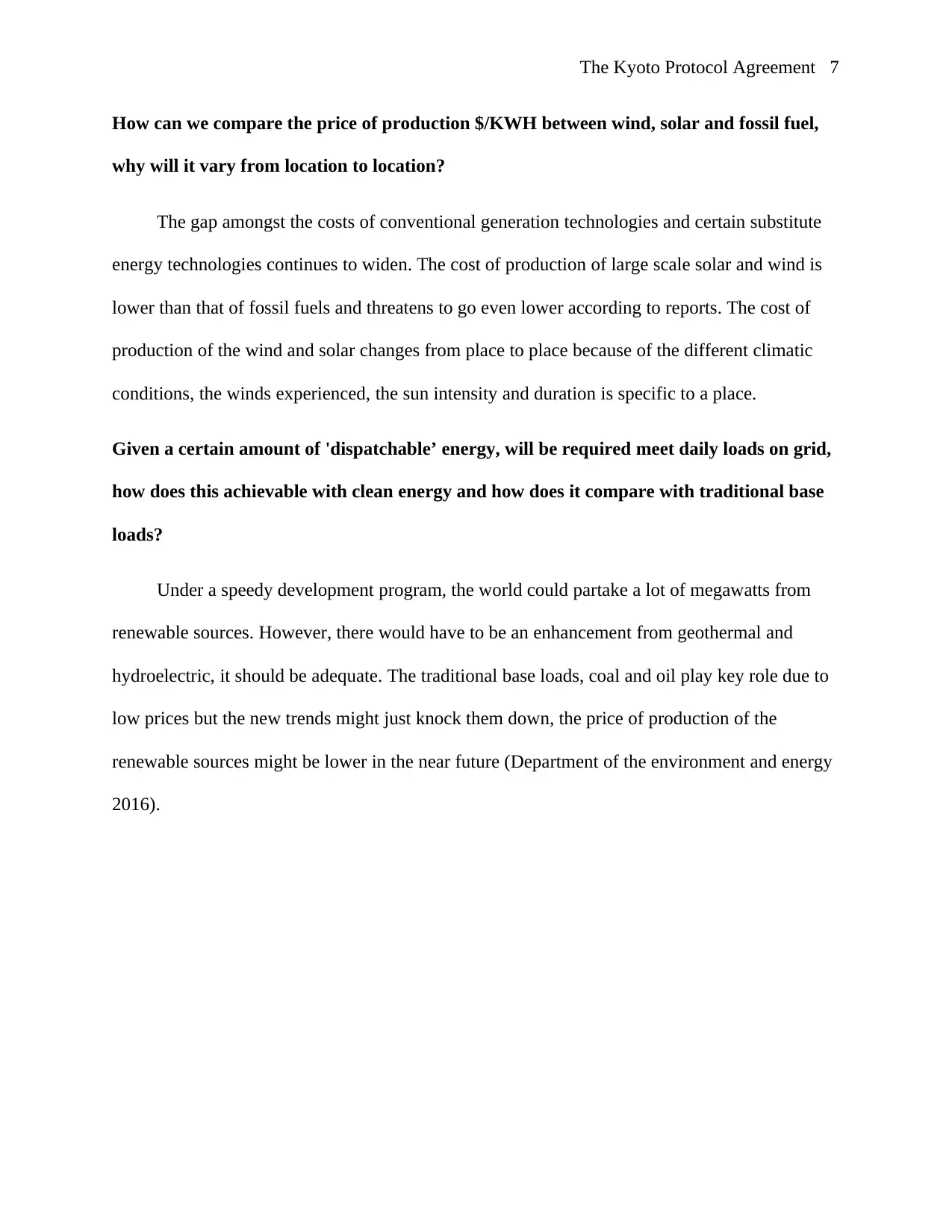
The Kyoto Protocol Agreement 7
How can we compare the price of production $/KWH between wind, solar and fossil fuel,
why will it vary from location to location?
The gap amongst the costs of conventional generation technologies and certain substitute
energy technologies continues to widen. The cost of production of large scale solar and wind is
lower than that of fossil fuels and threatens to go even lower according to reports. The cost of
production of the wind and solar changes from place to place because of the different climatic
conditions, the winds experienced, the sun intensity and duration is specific to a place.
Given a certain amount of 'dispatchable’ energy, will be required meet daily loads on grid,
how does this achievable with clean energy and how does it compare with traditional base
loads?
Under a speedy development program, the world could partake a lot of megawatts from
renewable sources. However, there would have to be an enhancement from geothermal and
hydroelectric, it should be adequate. The traditional base loads, coal and oil play key role due to
low prices but the new trends might just knock them down, the price of production of the
renewable sources might be lower in the near future (Department of the environment and energy
2016).
How can we compare the price of production $/KWH between wind, solar and fossil fuel,
why will it vary from location to location?
The gap amongst the costs of conventional generation technologies and certain substitute
energy technologies continues to widen. The cost of production of large scale solar and wind is
lower than that of fossil fuels and threatens to go even lower according to reports. The cost of
production of the wind and solar changes from place to place because of the different climatic
conditions, the winds experienced, the sun intensity and duration is specific to a place.
Given a certain amount of 'dispatchable’ energy, will be required meet daily loads on grid,
how does this achievable with clean energy and how does it compare with traditional base
loads?
Under a speedy development program, the world could partake a lot of megawatts from
renewable sources. However, there would have to be an enhancement from geothermal and
hydroelectric, it should be adequate. The traditional base loads, coal and oil play key role due to
low prices but the new trends might just knock them down, the price of production of the
renewable sources might be lower in the near future (Department of the environment and energy
2016).
Paraphrase This Document
Need a fresh take? Get an instant paraphrase of this document with our AI Paraphraser
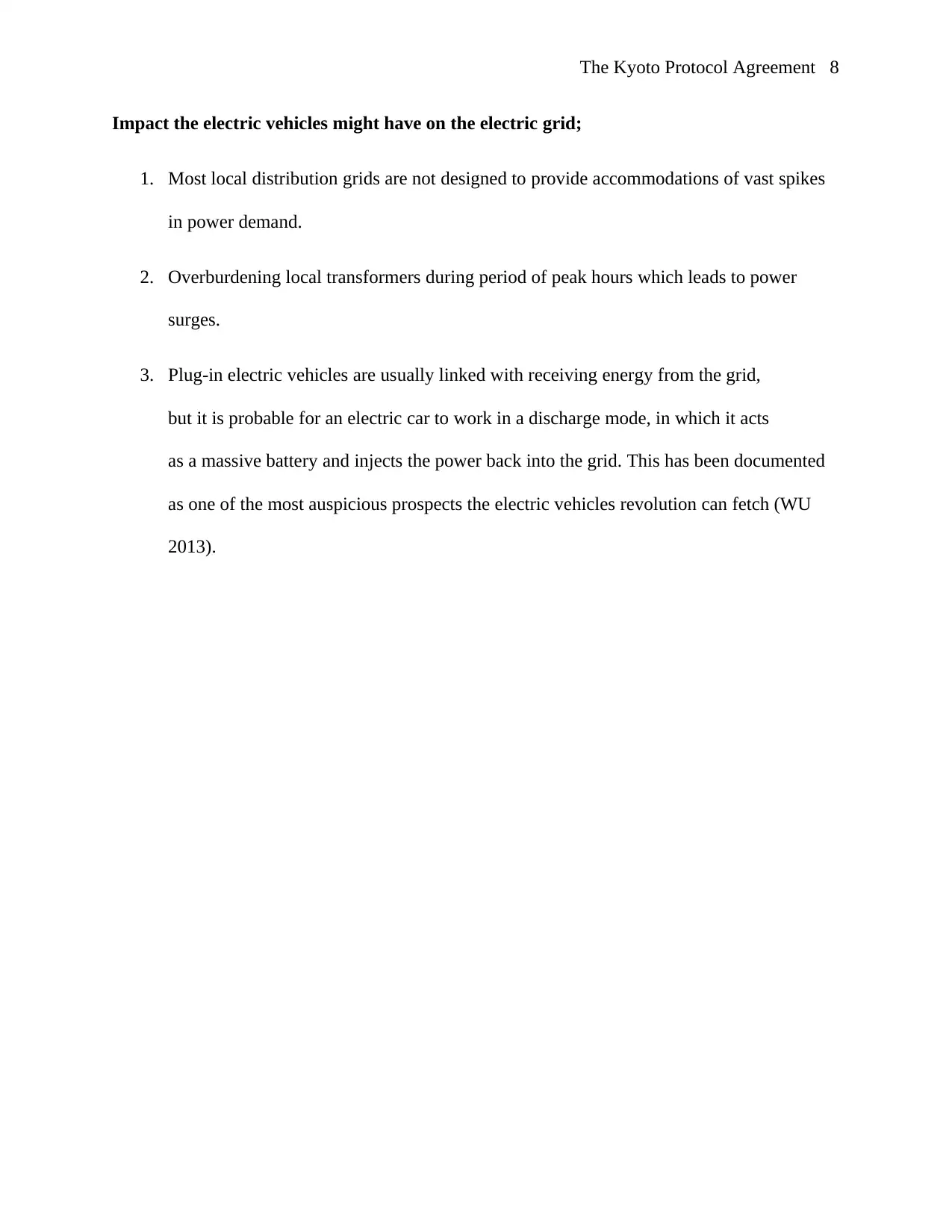
The Kyoto Protocol Agreement 8
Impact the electric vehicles might have on the electric grid;
1. Most local distribution grids are not designed to provide accommodations of vast spikes
in power demand.
2. Overburdening local transformers during period of peak hours which leads to power
surges.
3. Plug-in electric vehicles are usually linked with receiving energy from the grid,
but it is probable for an electric car to work in a discharge mode, in which it acts
as a massive battery and injects the power back into the grid. This has been documented
as one of the most auspicious prospects the electric vehicles revolution can fetch (WU
2013).
Impact the electric vehicles might have on the electric grid;
1. Most local distribution grids are not designed to provide accommodations of vast spikes
in power demand.
2. Overburdening local transformers during period of peak hours which leads to power
surges.
3. Plug-in electric vehicles are usually linked with receiving energy from the grid,
but it is probable for an electric car to work in a discharge mode, in which it acts
as a massive battery and injects the power back into the grid. This has been documented
as one of the most auspicious prospects the electric vehicles revolution can fetch (WU
2013).
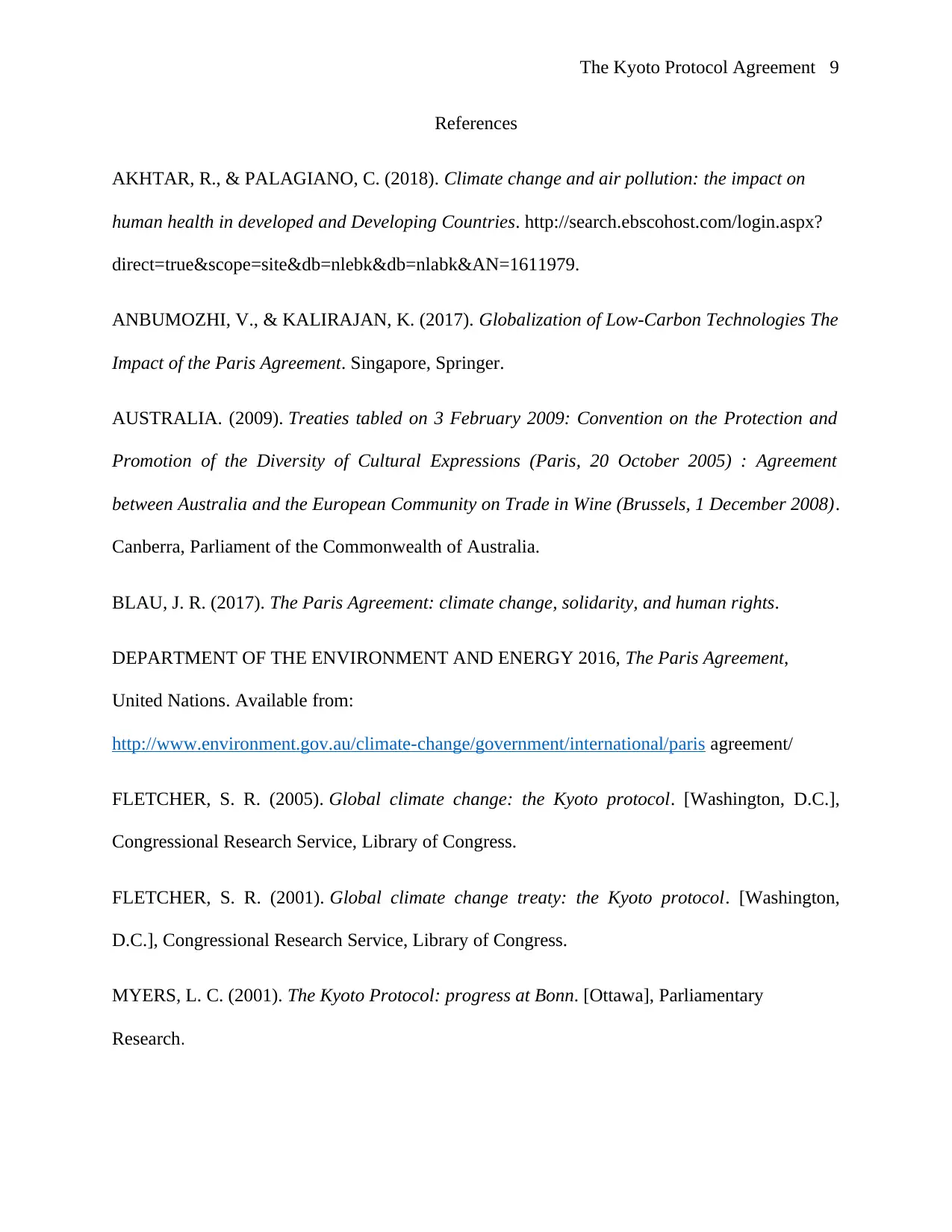
The Kyoto Protocol Agreement 9
References
AKHTAR, R., & PALAGIANO, C. (2018). Climate change and air pollution: the impact on
human health in developed and Developing Countries. http://search.ebscohost.com/login.aspx?
direct=true&scope=site&db=nlebk&db=nlabk&AN=1611979.
ANBUMOZHI, V., & KALIRAJAN, K. (2017). Globalization of Low-Carbon Technologies The
Impact of the Paris Agreement. Singapore, Springer.
AUSTRALIA. (2009). Treaties tabled on 3 February 2009: Convention on the Protection and
Promotion of the Diversity of Cultural Expressions (Paris, 20 October 2005) : Agreement
between Australia and the European Community on Trade in Wine (Brussels, 1 December 2008).
Canberra, Parliament of the Commonwealth of Australia.
BLAU, J. R. (2017). The Paris Agreement: climate change, solidarity, and human rights.
DEPARTMENT OF THE ENVIRONMENT AND ENERGY 2016, The Paris Agreement,
United Nations. Available from:
http://www.environment.gov.au/climate-change/government/international/paris agreement/
FLETCHER, S. R. (2005). Global climate change: the Kyoto protocol. [Washington, D.C.],
Congressional Research Service, Library of Congress.
FLETCHER, S. R. (2001). Global climate change treaty: the Kyoto protocol. [Washington,
D.C.], Congressional Research Service, Library of Congress.
MYERS, L. C. (2001). The Kyoto Protocol: progress at Bonn. [Ottawa], Parliamentary
Research.
References
AKHTAR, R., & PALAGIANO, C. (2018). Climate change and air pollution: the impact on
human health in developed and Developing Countries. http://search.ebscohost.com/login.aspx?
direct=true&scope=site&db=nlebk&db=nlabk&AN=1611979.
ANBUMOZHI, V., & KALIRAJAN, K. (2017). Globalization of Low-Carbon Technologies The
Impact of the Paris Agreement. Singapore, Springer.
AUSTRALIA. (2009). Treaties tabled on 3 February 2009: Convention on the Protection and
Promotion of the Diversity of Cultural Expressions (Paris, 20 October 2005) : Agreement
between Australia and the European Community on Trade in Wine (Brussels, 1 December 2008).
Canberra, Parliament of the Commonwealth of Australia.
BLAU, J. R. (2017). The Paris Agreement: climate change, solidarity, and human rights.
DEPARTMENT OF THE ENVIRONMENT AND ENERGY 2016, The Paris Agreement,
United Nations. Available from:
http://www.environment.gov.au/climate-change/government/international/paris agreement/
FLETCHER, S. R. (2005). Global climate change: the Kyoto protocol. [Washington, D.C.],
Congressional Research Service, Library of Congress.
FLETCHER, S. R. (2001). Global climate change treaty: the Kyoto protocol. [Washington,
D.C.], Congressional Research Service, Library of Congress.
MYERS, L. C. (2001). The Kyoto Protocol: progress at Bonn. [Ottawa], Parliamentary
Research.
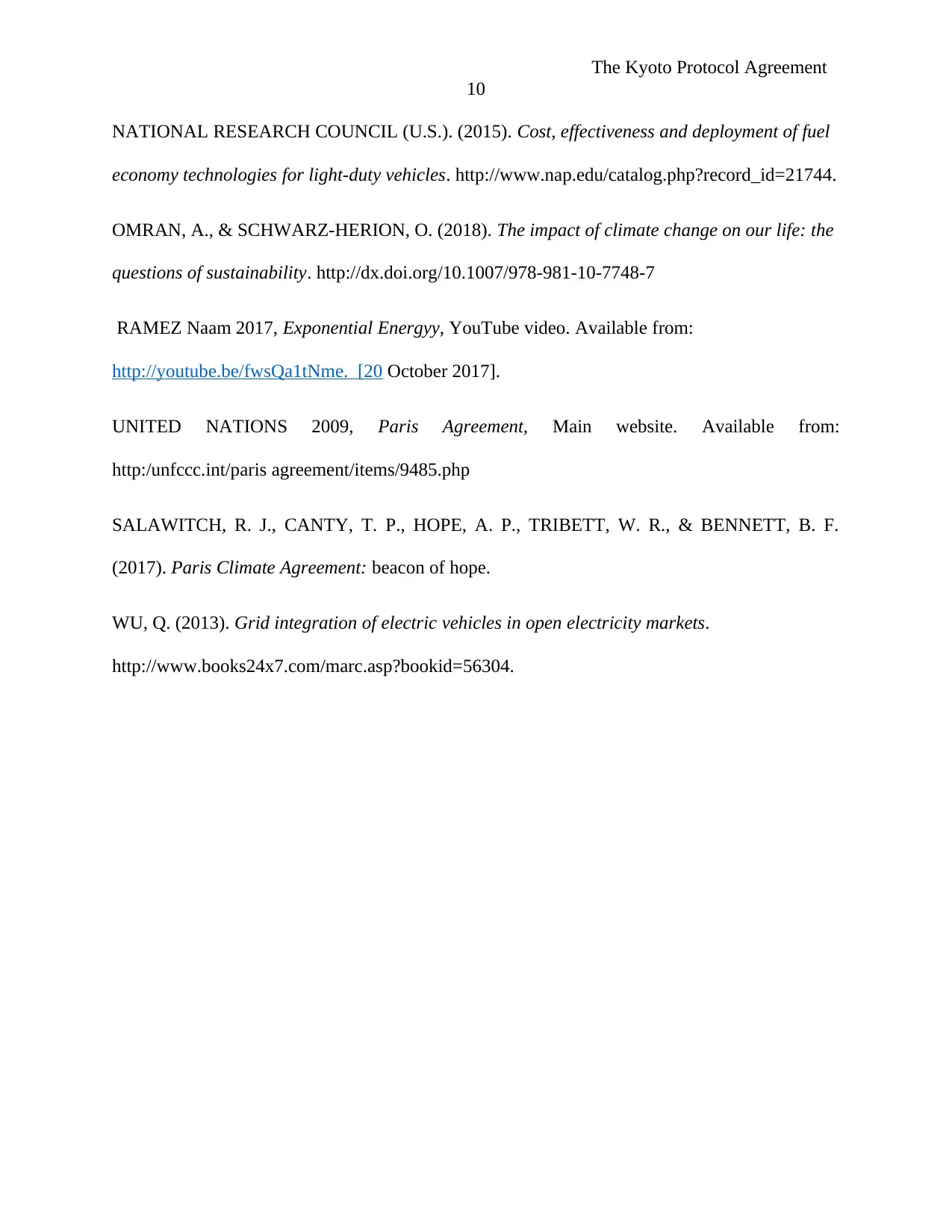
The Kyoto Protocol Agreement
10
NATIONAL RESEARCH COUNCIL (U.S.). (2015). Cost, effectiveness and deployment of fuel
economy technologies for light-duty vehicles. http://www.nap.edu/catalog.php?record_id=21744.
OMRAN, A., & SCHWARZ-HERION, O. (2018). The impact of climate change on our life: the
questions of sustainability. http://dx.doi.org/10.1007/978-981-10-7748-7
RAMEZ Naam 2017, Exponential Energyy, YouTube video. Available from:
http://youtube.be/fwsQa1tNme. [20 October 2017].
UNITED NATIONS 2009, Paris Agreement, Main website. Available from:
http:/unfccc.int/paris agreement/items/9485.php
SALAWITCH, R. J., CANTY, T. P., HOPE, A. P., TRIBETT, W. R., & BENNETT, B. F.
(2017). Paris Climate Agreement: beacon of hope.
WU, Q. (2013). Grid integration of electric vehicles in open electricity markets.
http://www.books24x7.com/marc.asp?bookid=56304.
10
NATIONAL RESEARCH COUNCIL (U.S.). (2015). Cost, effectiveness and deployment of fuel
economy technologies for light-duty vehicles. http://www.nap.edu/catalog.php?record_id=21744.
OMRAN, A., & SCHWARZ-HERION, O. (2018). The impact of climate change on our life: the
questions of sustainability. http://dx.doi.org/10.1007/978-981-10-7748-7
RAMEZ Naam 2017, Exponential Energyy, YouTube video. Available from:
http://youtube.be/fwsQa1tNme. [20 October 2017].
UNITED NATIONS 2009, Paris Agreement, Main website. Available from:
http:/unfccc.int/paris agreement/items/9485.php
SALAWITCH, R. J., CANTY, T. P., HOPE, A. P., TRIBETT, W. R., & BENNETT, B. F.
(2017). Paris Climate Agreement: beacon of hope.
WU, Q. (2013). Grid integration of electric vehicles in open electricity markets.
http://www.books24x7.com/marc.asp?bookid=56304.
1 out of 10
Your All-in-One AI-Powered Toolkit for Academic Success.
+13062052269
info@desklib.com
Available 24*7 on WhatsApp / Email
![[object Object]](/_next/static/media/star-bottom.7253800d.svg)
Unlock your academic potential
© 2024 | Zucol Services PVT LTD | All rights reserved.

